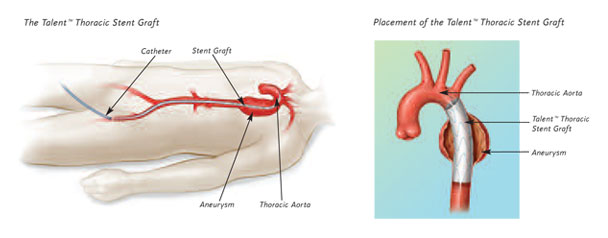Endovascular Stent Repair of Thoracic Aortic Aneurysms
Introduction
This booklet is provided to help you and your caregivers decide if a thoracic stent graft is right for you to treat a thoracic aortic aneurysm. Please read the booklet and discuss any questions with your doctor. Only a doctor can determine whether you are a good candidate for the procedure.
Are You a Good Candidate for the Talent™ Thoracic Stent Graft Procedure?
Anyone who is considering the Talent™ Thoracic Stent Graft procedure should:
- Be able to undergo a procedure that lasts one to three hours.
- Be able to attend regularly scheduled doctor’s visits and tests after the procedure, including at least one visit annually for life.
- Be fully informed about the risks and benefits of the Talent™ Thoracic Stent Graft procedure as compared to open surgical repair.
- Patients who have very large aneurysms and/or vessels with many bends or curves may not be good candidates for the stent graft procedure. Discuss with your doctor which treatment is best for you.
How is the Talent Abdominal Stent Graft procedure performed?
The procedure is performed under regional or general anesthesia. Before the procedure, several tests are performed that let your doctor see the aneurysm and the area around it. These tests are usually performed using imaging such as a CT scan. A CT scan is an imaging technique that creates a series of X-rays that are used to form a picture of your aneurysm and adjacent blood vessels. A CT scan does not hurt and you will be awake for this testing.
To prepare for the stent graft procedure, a small cut is made in your groin to allow access for the stent graft delivery catheter into the femoral artery. Sometimes the doctor will use a conduit (a surgical graft attached to a larger artery in your pelvis) if the artery in your groin is too small to deliver the device. The doctor uses fluoroscopy (video-like X-rays) to see the device move through the blood vessel in your groin. The doctor also uses fluoroscopy to correctly position the device over the aneurysm in your descending thoracic aorta.

When the delivery catheter is properly placed, the Talent™ Thoracic Stent Graft is released slowly from the delivery catheter into the aorta. As the stent graft is released, it expands automatically to its proper size (see Figure 7) so that it fits snugly to the aorta both above and below the aneurysm.
Depending on the shape and size of your aneurysm, additional stent grafts may be used. This ensures that the stent grafts span the full length of the aneurysm and blood is no longer flowing into the aneurysm. Fluoroscopy is then performed to allow your doctor to see that the stent graft has been placed properly. The procedure typically takes one to three hours to complete.
Patients often leave the hospital within one or two days of the procedure. Patients can usually return to their normal quality of life within a few weeks.
What are the Risks?
As with any endovascular stent graft, the Talent Abdominal Stent Graft comes with risks. Please discuss all risks with your doctor. Major risks associated with abdominal endovascular stent grafts include, but are not limited to:
Clinically Associated Events
The endovascular stent graft procedure is a surgical procedure; as such, there are possible complications associated with the procedure.
Before deciding if the procedure is right for you, please review the list of possible procedural complications with your doctor:
|
|
Device Related Events
Endovascular stent grafting is a new therapy. Therefore, long term safety and effectiveness of the Talent™ Thoracic Stent Graft has not been established. Please discuss with your doctor if this therapy is right for you.
Possible complications of the device may include, but are not limited to the following:
- Leaking of blood around the graftx (“Endoleak”)
- Movement of the graft away from the desired location (“Migration”)
- Additional procedures
What are the Benefits?
There are a number of benefits that are related to having a thoracic stent graft procedure:
- A lower risk of death compared to open surgery.
- The patient loses less blood during the procedure.
- The patient will spend less time in the intensive care unit after the procedure.
- The patient will have a shorter hospital stay with faster recovery time compared with open surgery
Please discuss the benefits of all treatment options with your doctor so that you can determine which procedure is right for you.
